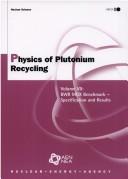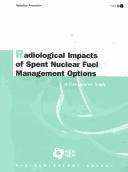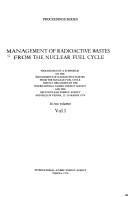| Listing 1 - 10 of 19 | << page >> |
Sort by
|

ISBN: 1280034599 9786610034598 926429905X 9264199055 Year: 2003 Publisher: Paris : OECD Publishing,
Abstract | Keywords | Export | Availability | Bookmark
 Loading...
Loading...Choose an application
- Reference Manager
- EndNote
- RefWorks (Direct export to RefWorks)
The OECD/NEA Working Party on the Physics of Plutonium Fuels and Innovative Fuel Cycles (WPPR) conducted a physics code benchmark test for the recycling of plutonium as PuO2/UO2 mixed-oxide (MOX) fuel in boiling water reactors (BWRs) compared to pressurised water reactors (PWRs). This volume reports on the benchmark results and conclusions that can be drawn from it.
Book
ISBN: 0323993087 0323993095 9780323993098 9780323993081 Year: 2022 Publisher: [S.l.] Academic Press
Abstract | Keywords | Export | Availability | Bookmark
 Loading...
Loading...Choose an application
- Reference Manager
- EndNote
- RefWorks (Direct export to RefWorks)
Book
ISBN: 9264010440 9789264010444 Year: 1973
Abstract | Keywords | Export | Availability | Bookmark
 Loading...
Loading...Choose an application
- Reference Manager
- EndNote
- RefWorks (Direct export to RefWorks)
Reactor fuel reprocessing --- Combustibles nucléaires irradiés --- Waste disposal --- Traitement --- Déchets --- Elimination --- -Nuclear reactor fuel reprocessing --- Reprocessing of nuclear fuels --- Spent reactor fuel processing --- Fission products --- Nuclear fuels --- Waste products --- Accelerator-driven systems --- -Waste disposal --- Combustibles nucléaires irradiés --- Déchets --- Radioactive waste disposal
Book
ISSN: 00741914 ISBN: 920155589X Year: 1989 Volume: vol 305
Abstract | Keywords | Export | Availability | Bookmark
 Loading...
Loading...Choose an application
- Reference Manager
- EndNote
- RefWorks (Direct export to RefWorks)
Nuclear fuels --- Plutonium --- Reactor fuel reprocessing --- Uranium --- Actinide elements --- Metals --- Transuranium elements --- Nuclear reactor fuel reprocessing --- Reprocessing of nuclear fuels --- Spent reactor fuel processing --- Fission products --- Waste products --- Accelerator-driven systems --- Transplutonium elements --- Atomic fuel --- Fission fuel --- Nuclear reactors --- Reactor fuels --- Fuel --- Radioactive substances --- Report

ISBN: 1280034211 9786610034215 9264182020 9789264182028 9264176578 Year: 2000 Publisher: Paris : OECD Publishing,
Abstract | Keywords | Export | Availability | Bookmark
 Loading...
Loading...Choose an application
- Reference Manager
- EndNote
- RefWorks (Direct export to RefWorks)
Given its potential significance for public health and the environment, the impact of radioactive releases during important steps of nuclear energy production must be considered when selecting among different fuel cycles. With this in mind, the OECD Nuclear Energy Agency (NEA) has undertaken a comparative study of the radiological impacts of two main fuel cycle options: one with and one without reprocessing of spent nuclear fuel. The study compares the respective impacts of the two options based on generic models and assumptions as well as actual data. It concludes that the difference between them is not significant. A wealth of recent data assembled and evaluated by an international expert team is provided in annex.
Nuclear fuels -- Management. --- Nuclear fuels. --- Spent reactor fuels. --- Spent reactor fuels --- Reactor fuel reprocessing --- Nuclear fuels --- Radiation --- Nuclear Engineering --- Mechanical Engineering --- Engineering & Applied Sciences --- Management --- Safety measures --- Atomic fuel --- Fission fuel --- Nuclear reactors --- Reactor fuels --- Nuclear reactor fuel reprocessing --- Reprocessing of nuclear fuels --- Spent reactor fuel processing --- Fuel --- Reactor fuel reprocessing. --- Management. --- Radioactive substances --- Fission products --- Waste products --- Accelerator-driven systems
Book
ISBN: 1282304666 9786612304668 9264047735 9264047727 Year: 2009 Publisher: Paris : OECD : Nuclear Energy Agency,
Abstract | Keywords | Export | Availability | Bookmark
 Loading...
Loading...Choose an application
- Reference Manager
- EndNote
- RefWorks (Direct export to RefWorks)
This 2009 edition of Nuclear Energy Data, the OECD Nuclear Energy Agency's annual compilation of essential statistics on nuclear energy in OECD countries, provides information on plans for new nuclear construction, nuclear fuel cycle developments and projections of installed nuclear capacity to 2035 in OECD member countries. This comprehensive overview of the current situation and expected trends in various sectors of the nuclear fuel cycle provides authoritative information for policy makers, experts and academics working in the nuclear energy field.
Electric power production -- Statistics -- Periodicals. --- Nuclear power plants -- Statistics -- Periodicals. --- Organisation for Economic Co-operation and Development -- Periodicals. --- Nuclear industry --- Nuclear power plants --- Electric utilities --- Reactor fuel reprocessing --- Nuclear reactor fuel reprocessing --- Reprocessing of nuclear fuels --- Spent reactor fuel processing --- Atomic power plants --- Nuclear power stations --- Power plants, Nuclear --- Atomic energy industries --- Atomic industry --- Atomic power industry --- Nuclear energy industry --- Nuclear power industry --- Fission products --- Nuclear fuels --- Waste products --- Accelerator-driven systems --- Nuclear facilities --- Power-plants --- Antinuclear movement --- Nuclear energy --- Energy industries
Book
Abstract | Keywords | Export | Availability | Bookmark
 Loading...
Loading...Choose an application
- Reference Manager
- EndNote
- RefWorks (Direct export to RefWorks)
621.039 --- Nuclear fuels --- Reactor fuel reprocessing --- Plutonium as fuel --- Nuclear reactor fuel reprocessing --- Reprocessing of nuclear fuels --- Spent reactor fuel processing --- Fission products --- Waste products --- Accelerator-driven systems --- Atomic fuel --- Fission fuel --- Nuclear reactors --- Reactor fuels --- Fuel --- Radioactive substances --- Applied nuclear science. Atomic energy and atomic industry. Nuclear engineering in general --- Nuclear fuels. --- Plutonium as fuel. --- Reactor fuel reprocessing. --- 621.039 Applied nuclear science. Atomic energy and atomic industry. Nuclear engineering in general --- Report

ISBN: 9200202764 9200203760 9789200203763 Year: 1976 Publisher: Vienna International atomic energy agency
Abstract | Keywords | Export | Availability | Bookmark
 Loading...
Loading...Choose an application
- Reference Manager
- EndNote
- RefWorks (Direct export to RefWorks)
The increased emphasis in many countries on the development and utilization of nuclear power is leading to an expansion of all sectors of the nuclear fuel cycle, giving rise to important policy issues and radioactive-waste management requirements. Consequently, the IAEA and the Nuclear Energy Agency of OECD felt that it would be timely to review latest technology for the management of the radioactive wastes arising from nuclear fuel cycle facilities, to identify where important advances have been made, and to indicate those areas where further technological development is needed. Beginning in 1959, the IAEA, either by itself or jointly with OECD/NEA has held seven international symposia on the management of radioactive wastes. The last symposium, on the management of radioactive wastes from fuel reprocessing, was held jointly by the IAEA and OECD/NEA in Paris in November 1972. An objective of the 1976 symposium was to update the information presented at the previous symposia with the latest technological developments and thinking regarding the management and disposal of all categories of radioactive wastes. Consequently, although the scope of the symposium was rather broad, attention was focussed on operational experience and progress in unresolved areas of radioactive waste management. The programme dealt primarily with the solidification of liquid radioactive wastes and disposal of the products, especially the high-level fission products and actinide-containing waste from fuel reprocessing. Other topics covered policy and planning, treatment of hulls and solvent, management of plutonium-contaminated waste, and removal of gaseous radionuclides. The major topic of interest was the current state of the technology for the reduction and incorporation of the high-level radioactive liquid from fuel reprocessing into solid forms, such as calcines, glasses or ceramics, for safe interim storage and eventual disposal. The approaches to vitrification ranged from two stage processes that first produce a calcine, which then is incorporated into a glass melt, to processes which vitrify the concentrated high-level liquid waste in one step. A novel approach, being investigated at Eurochemic, is the incorporation of a high-level waste calcine into metal matrices
Radioactive waste disposal --- Reactor fuel reprocessing --- Déchets radioactifs --- Congresses --- Waste products --- Elimination --- Congrès --- -Reactor fuel reprocessing --- -Nuclear reactor fuel reprocessing --- Reprocessing of nuclear fuels --- Spent reactor fuel processing --- Fission products --- Nuclear fuels --- Accelerator-driven systems --- Nuclear waste disposal --- Nuclear engineering --- Radioactivity --- Refuse and refuse disposal --- Radioactive pollution --- -Congresses --- Safety measures --- 621.039.7 --- Radioactive waste management --- Congresses. --- 621.039.7 Radioactive waste management --- Déchets radioactifs --- Congrès --- Nuclear reactors --- Réacteurs nucléaires --- Combustibles nucléaires irradiés --- Élimination --- Traitement --- Nuclear reactor fuel reprocessing --- Waste products&delete& --- Report --- Monograph --- Réacteurs nucléaires. --- Élimination. --- Traitement. --- Waste products.
Book
Abstract | Keywords | Export | Availability | Bookmark
 Loading...
Loading...Choose an application
- Reference Manager
- EndNote
- RefWorks (Direct export to RefWorks)
Reactor fuel reprocessing --- Combustibles nucléaires irradiés --- Traitement --- Organisation for Economic Co-operation and Development --- 621.039 --- AA / International- internationaal --- 338.753.3 --- Nuclear reactor fuel reprocessing --- Reprocessing of nuclear fuels --- Spent reactor fuel processing --- Fission products --- Nuclear fuels --- Waste products --- Accelerator-driven systems --- Applied nuclear science. Atomic energy and atomic industry. Nuclear engineering in general --- Kernenergie. --- OECD --- 621.039 Applied nuclear science. Atomic energy and atomic industry. Nuclear engineering in general --- OESO --- OCDE --- Combustibles nucléaires irradiés --- Organisation for Economic Co-operation and Development. --- Kernenergie
Book
ISBN: 3319225863 3319225871 Year: 2015 Publisher: Cham : Springer International Publishing : Imprint: Springer,
Abstract | Keywords | Export | Availability | Bookmark
 Loading...
Loading...Choose an application
- Reference Manager
- EndNote
- RefWorks (Direct export to RefWorks)
The present work focuses on the development of intensified small-scale extraction units for spent nuclear fuel reprocessing using advanced process engineering with combined experimental and modelling methodologies. It discusses a number of novel elements, such as the intensification of spent fuel reprocessing and the use of ionic liquids as green alternatives to organic solvents. The use of ionic liquids in two-phase liquid-liquid separation is new to the Multiphase Flow community, and has proved to be challenging, especially in small channels, because of the surface and interfacial properties involved, which are very different to those of common organic solvents. Numerical studies have been also performed to couple the hydrodynamics at small scale with the mass transfer. The numerical results, taken together with scale-up studies, are used to evaluate the applicability of the small-scale units in reprocessing large volumes of nuclear waste.
Physical & Theoretical Chemistry --- Chemistry --- Physical Sciences & Mathematics --- Reactor fuel reprocessing. --- Separation (Technology) --- Nuclear reactor fuel reprocessing --- Reprocessing of nuclear fuels --- Spent reactor fuel processing --- Chemistry. --- Nuclear energy. --- Chemical engineering. --- Nuclear chemistry. --- Nuclear Chemistry. --- Industrial Chemistry/Chemical Engineering. --- Safety in Chemistry, Dangerous Goods. --- Nuclear Energy. --- Chemistry, Analytic --- Chemistry, Technical --- Technology --- Fission products --- Nuclear fuels --- Waste products --- Accelerator-driven systems --- Chemicals --- Safety measures. --- Chemistry, Industrial --- Engineering, Chemical --- Industrial chemistry --- Engineering --- Metallurgy --- Chemistry, Nuclear --- Chemistry, Physical and theoretical --- Analytical chemistry --- Atomic energy --- Atomic power --- Energy, Atomic --- Energy, Nuclear --- Nuclear power --- Power, Atomic --- Power, Nuclear --- Force and energy --- Nuclear physics --- Power resources --- Nuclear engineering --- Nuclear facilities --- Nuclear power plants --- Physical sciences
| Listing 1 - 10 of 19 | << page >> |
Sort by
|

 Search
Search Feedback
Feedback About
About Help
Help News
News